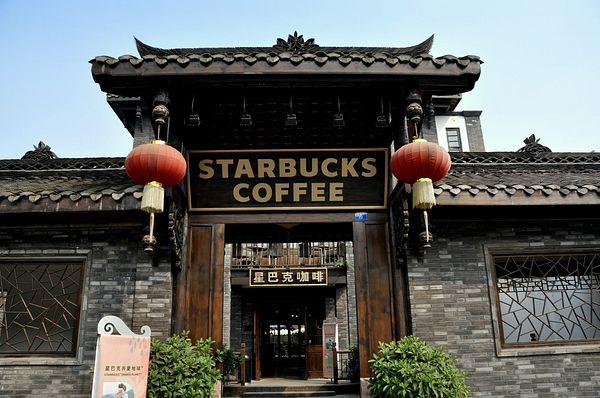Why is China Starbuck’s biggest market?
Note: If you are new to characters or generally want some support while working through the example sentences in the next sections, we HIGHLY recommend downloading this plugin! It will help a ton with character reading, both in this article, and on the greater web in general. If you’ve already installed it, carry on! :)
American food service brands in China is one of the clearest signs of Mainland China’s (from this point on referred to as China) growing connection with the West since opening up in the 1970s.
Cuisine is one of the most important parts of culture. The experience of American food brands in China shows how American culture has influenced China and also how Chinese culture has influenced traditional American menus.
Many classic American brands, such as McDonald’s, Coca-Cola, and KFC, have had successful ventures in China.
However, these brands’ success arguably is nothing compared to the success Starbucks (星巴克) has had in China. ☕
Of all countries, only the USA has more Starbucks stores than China, 15,000 compared to around 6,000 near the end of 2022. For your reference, the 3rd place award goes to Canada at around 2,000 stores.
However, the upscale coffee giant plans to open a new Starbucks store every 9 hours for the next 3 years, meaning that this gap is decreasing 非常快. 🏎️
But how on Earth did Starbucks, a coffee-centric brand, succeed in China, a country whose culture has prioritized 🍵 over ☕ for thousands of years?
Grab a cup of whatever caffeinated beverage you prefer and let’s find out!
TLDR
Two key factors that allowed Starbucks to succeed in China are:
Adapting well to Chinese tea house culture and family values
Positioning Starbucks to be a “luxury item”
Adapting to Chinese Culture
“谦受益,满招损“: “Modesty receives reward, while arrogance invites loss”.
This was the key to Starbucks’ success! Rather than being arrogant and expecting Chinese consumers to adapt to American tastes, Starbucks remained modest (“客气” or “谦虚”) and adapted their American model to Chinese tastes.
To start with, Starbucks made sure when they entered the Chinese market to provide tea-based drinks to Chinese consumers who would be more familiar with tea.
This adjustment of traditional menus to Chinese tastes continues to this day, with Starbucks providing items specialized for Chinese tastes and even regional tastes.
However, what I think is the most interesting adaptation to Chinese culture is the starkly different layout of Chinese Starbucks stores.
The traditional American 咖啡馆 layout is usually imagined as a small coffee shop in which people usually do 1 of 3 things:
Get coffee, leave
Get coffee, sit and do work on a laptop
Get coffee, chat with one other person
This is very different from the traditional Chinese tea house(茶馆) layout. Throughout Chinese history, teahouses have been places where large groups of people gather to not just drink tea but also socialize, doing things like:
Playing board/card games (FunFact: Playing cards were invented in China 🃏)
Playing amateur music, such as the famous 江南丝竹 (Silk and Bamboo Music)
Overall, the traditional 茶馆 is much larger and livelier than the American 咖啡馆.
With this in mind, Starbucks made the astute decision to design their Chinese stores to resemble the traditional 茶馆. Here are some pictures for a comparison:
Interior of American StarBucks
Note how the Chinese Starbucks is much more open and expansive than the American one, and also note how the “many chairs around a table” layout in the Chinese Starbucks resembles the layout in the Chinese teahouse above.
Starbucks has adapted to Chinese culture not just through its customer offerings but also through its employee benefits.
One of the phrases most commonly associated with Chinese culture is “filial piety” (孝). In essence, filial piety argues that all people should respect and care for their elders, especially their parents.
With this in mind, Starbucks was understanding enough of its employees to provide them health insurance benefits for their parents, allowing them to better care for their parents, which I personally think is something we should all do.
A Specialized Pricing Strategy
Another key ingredient in Starbucks’s success in China has been its pricing strategy.
In the United States, Starbucks is already priced as and viewed as higher in class than other brands’ coffees, such as McDonald’s. For your reference, while at the time of writing, a McDonald’s cup of coffee costs only around $1.00, Starbucks standard drip coffee can be as expensive as $3.00.
However, in China Starbucks took this higher-prestige strategy to the extreme. They did not reduce drink prices for Chinese consumers, even if China was a developing, middle-income country. In some cases, Starbucks drinks in China cost even more than the same drinks in the USA!
Starbucks also made sure to make their stores look posh and be positioned in luxury-associated areas, such as business districts and shopping malls.
By doing this, Starbucks was able to position its products as being not merely a step above McDonald’s drinks but rather luxury items on par with brands like Louis Vuitton, Rolex, etc..
Can the millions who make up China’s working class afford to buy Starbucks coffee every day, or even only 一周一次? 不可能吧!
However, can the millions who make up China’s rapidly increasing urban middle class afford to buy Starbucks to make themselves look posh? 当然可以!
Starbucks has been targeting relatively wealthy city dwellers, and especially young people. These people have been coming to Starbucks in droves, and it doesn’t appear that they’ll stop anytime soon.
Personal note: I once took a class with a Chinese international student who never failed to show up to class without a large iced Starbucks drink. Truly, this individual was one of Starbucks’s Chinese 粉丝.
To Conclude
Starbucks has been one of the most successful American corporations doing business in China, and key ingredients in its success included its adaptation to Chinese culture and positioning itself as a luxury item.
We all are not corporations, but Starbucks’s success in China does hold a valuable lesson for us humans, which is that understanding and adapting to other cultures can be very rewarding.
By learning Chinese, you as a language-learner are already taking an awesome step towards understanding the culture of almost 20% of the world’s population. Who knows, perhaps by mastering Chinese and learning more about Chinese culture you’ll reap rewards like Starbucks has!





